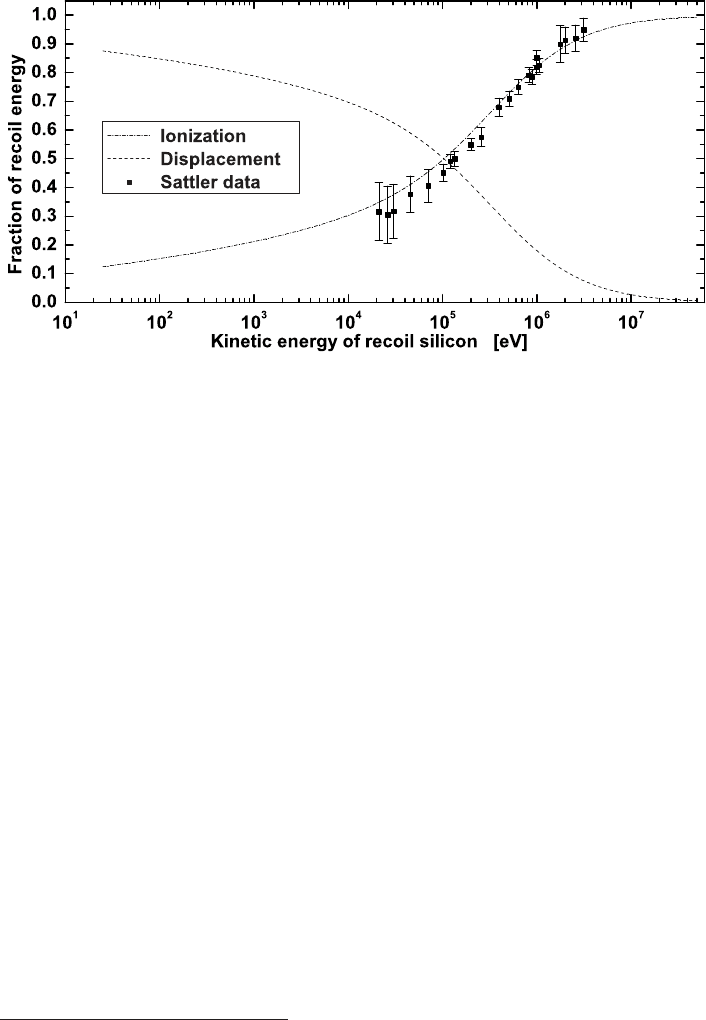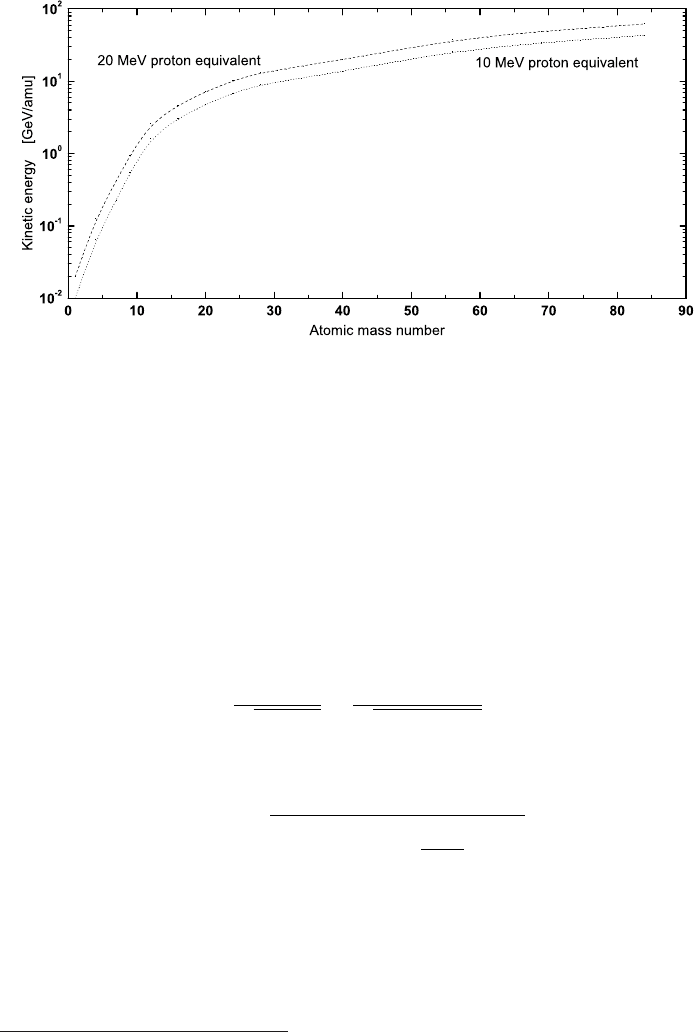Leroy C., Rancoita P.-G. Principles Of Radiation Interaction In Matter And Detection
Подождите немного. Документ загружается.


January 9, 2009 10:21 World Scientific Book - 9.75in x 6.5in ws-bo ok975x65˙n˙2nd˙Ed
350 Principles of Radiation Interaction in Matter and Detection
from which we get
κ =
·
Z
E
min
D(E)
D(1 MeV)
φ(E) dE
¸µ
Z
E
min
φ(E) dE
¶
−1
(4.84)
and, conversely,
Φ
1 MeV
eq
=
Z
E
min
D(E)
D(1 MeV)
φ(E) dE. (4.85)
As already mentioned, in some calculations the value used for E
min
is about
10 keV. Values of the hardness parameter for some neutron reactor spectra can
be found in [Angelescu et al. (1994)] and, for E
min
= 10 keV, in [Kelly, Luera,
Posey and Williams (1988)].
By replacing the spectral fluence with the neutron kinetic-energy distribution
F (E) obtained by integrating the spectral fluence (assumed to be independent of
the position) over the exposed area F (E) =
R
φ(E) dS, we can rewrite Eq. (4.81) and
obtain the damage energy lost per unit length, i.e., the non-ionization energy-loss
in units of MeV per cm:
dE
de
dx
=
Z
E
dis
dS
= n
Si
Z
D(E) F (E) dE [MeV/cm]. (4.86)
For a neutron with kinetic energy E, the NIEL amounts to
dE
n
de
dx
= n
Si
D(E). (4.87)
Equations (4.86, 4.87) can be used to express the relationship between the da-
mage function and the non-ionizing energy-loss per unit path for any kind of beam
particles with a kinetic-energy distribution F (E) or at fixed kinetic-energy E. Equa-
tion (4.87) can be rewritten in terms of the differential cross section dσ
k
(E)/dE
R
for any incoming particle with kinetic energy E resulting in a nuclear recoil with
kinetic energy E
R
:
dE
de
dx
= n
Si
X
k
Z
E
max
R
E
d
dσ
k
(
E
)
dE
R
P
k
(E
R
) dE
R
, (4.88)
where E
max
R
is the maximum energy transferred to the recoil nucleus and the sum-
mation is extended over the possible k reaction channels which allow the generation
of a recoil silicon (for example in the elastic scattering) or a residual nucleus.
4.2.1.1 Knock-on Atoms and Displacement Cascade
When a semiconductor (as any solid material) is subjected to incident radiation
(i.e. neutrons, electrons, protons, ions. . . ), the resulting degree of damage depends
on a number of factors. For instance, the type of interaction (strong or electromag-
netic), the nature and energy of the incoming particle determine the initial-damage,

January 9, 2009 10:21 World Scientific Book - 9.75in x 6.5in ws-bo ok975x65˙n˙2nd˙Ed
Radiation Environments and Damage in Silicon Semiconductors 351
i.e., the number of atoms directly displaced (PKAs) by the incoming particles and
their energy spectrum. These PKAs, in turn, can generate a cascade of displa-
cements, i.e., the cascading damage. That is, the primary displaced atoms, upon
leaving their lattice positions with large enough energies, can interact and displace
other atoms. In this way, a displacement cascade is generated upon full dissipation
of the primary recoil-energy. In the cascade, the energy dissipation is a combination
of elastic interactions (referred to as nuclear or elastic energy-loss
‡‡
) mostly result-
ing in displacements and inelastic processes (referred to as electronic or inelastic
energy-loss), in which moving displaced-atoms excite or ionize atomic electrons on
their passage
§
. The point defects (see Sect. 4.2.2), created in the silicon lattice at
this initial stage, are often referred to as primary. Secondary defects are created
during the diffusion of these primary defects.
The primary recoil energy is deposited by the ionization energy, E
loss
, (including
that deposited by recoiling atoms in the cascade when it occurs) and damage energy
(also referred to as partition or defect producing energy), E
de
, accounting for di-
splacements and sub-threshold collisions, which transfer energies lower than E
d
. In
these latter interactions, the knock-on atom cannot escape from its lattice location
and the energy is dissipated in lattice vibrations, as mentioned in Sect. 4.2. The
non-ionizing energy-loss (NIEL) is the damage-energy deposited by an incoming
particle per unit length (e.g., in units of MeV/cm in this section, if not specified
otherwise). As discussed in Sect. 4.2.1, permanent radiation-damage is induced by
atoms displaced from their lattice locations and, as a consequence, is related to the
amount of damage energy.
As already discussed, the energy and differential cross section of the incoming
particle determine the energy spectrum of the primary recoil. However, the se-
condary interactions can be treated in the framework of atom–atom interactions
∗
which, for recoil atoms at low energy, are described by largely screened Coulomb
potentials. Kinchin and Pease (1955) estimated the average number of displaced
atoms generated by a PKA with recoiling energy above E
d
, assuming (i) two-body
hard-sphere atomic collisions, (ii) a sharp displacement threshold E
d
and (iii) no in-
elastic energy-losses (i.e. no ionization energy-loss in secondary collisions). Torrens
and Robinson (see [Torrens and Robinson (1972); Robinson and Torrens (1974);
‡‡
For a further discussion see, for instance, Sects. 2.1.4 and 2.1.4.1; see, also, Chapter 2 of [Ziegler,
Biersack and Littmark (1985a); Ziegler, J.F. and M.D. and Biersack (2008a)].
§
For incoming high-energy particles, this type of energy-loss process is commonly referred to
as collision energy-loss process (e.g., see Sects. 2.1, 2.1.1, 2.1.4 and discussion in the chapter on
Electromagnetic Interaction of Radiation in Matter ; in addition see Chapter 3 of [Ziegler, Biersack
and Littmark (1985a); Ziegler, J.F. and M.D. and Biersack (2008a)]).
∗
The reader can see, for instance, Sections 2.2–2.4 of [Dienes and Vineyard (1957)], Section 2.2.8
of [van Lint, Flanahan, Leadon, Naber and Rogers (1980)], [Ziegler, Biersack and Littmark (1985a);
Ziegler, J.F. and M.D. and Biersack (2008a)] and references therein.

January 9, 2009 10:21 World Scientific Book - 9.75in x 6.5in ws-bo ok975x65˙n˙2nd˙Ed
352 Principles of Radiation Interaction in Matter and Detection
Fig. 4.15 Fractions of kinetic energy of recoil silicon deposited in processes producing de-
fects (dashed line) and ionization-losses (dashed and dotted line) [calculated by means of
Eqs. (4.94, 4.95)] (from [Leroy and Rancoita (2007)]). The experimental data (¥) are from [Sattler
(1965)].
Norgett, Robinson and Torrens (1975)] and references therein) have estimated
¶
the average number of displacements < N
F P
>, i.e., of Frenkel-pairs, by means of
extensive computer simulations of collision cascades accounting for inelastic losses
and the damage energy left available. The number of Frenkel-pairs generated in a
cascade is given by the modified Kinchin–Pease formula
< N
F P
> =
1 for E
d
< E
de
≤ 2 E
d
/ζ,
ζE
de
/(2E
d
) for E
de
> 2 E
d
/ζ,
(4.89)
where ζ ≈ 0.8 is a constant independent of energy (except for recoil energy close to
2E
d
[Norgett, Robinson and Torrens (1975)]). The factor ζ is called displacement
efficiency (e.g., see discussion at pages 425 and 431–435 in [Torrens and Robin-
son (1972)]). For silicon, as discussed at page 347, the threshold energy to create
a displacement is about 25 eV. In Eq. (4.89), the factor 2 was determined in the
framework of the above mentioned Kinchin–Pease analytical treatment, in which
a sharp displacement threshold energy, E
d
, is assumed. When a more realistic in-
teratomic potential is used instead of the hard-sphere model, low-energy transfers
are favored, thus resulting in a smaller number of displaced atoms per cascade. The
displacement efficiency is the parameter accounting for such a decrease and for the
effects of thermal vibrations in the lattice.
The energy depositions E
loss
and E
de
can be computed by means of analytical
¶
For Cu, a comparison between < N
F P
> computed using the modified Kinchin–Pease formula
and that created by electrons and ions can be found in [Merkle, King, Baily, Haga and Meshii
(1983)].

January 9, 2009 10:21 World Scientific Book - 9.75in x 6.5in ws-bo ok975x65˙n˙2nd˙Ed
Radiation Environments and Damage in Silicon Semiconductors 353
approximation of Robinson [Robinson (1970)] used, for instance, in the SRIM
‡‡
code
(see pages 115–166 in [Ziegler, Biersack and Littmark (1985a)] and also [Ziegler, J.F.
and M.D. and Biersack (2008b)]). In a silicon medium, for a recoil silicon nucleus
with kinetic energy E
Si
in eV and atomic number Z
Si
= 14 we have
E
de
=
E
Si
1 + k
d
g(²
d
)
, (4.90)
where:
²
d
= 1.014 × 10
−2
Z
−7/3
Si
E
Si
= 2.147 × 10
−5
E
Si
, (4.91)
g(²
d
) = ²
d
+ 0.40244 ²
3/4
d
+ 3.4008 ²
1/6
d
, (4.92)
k
d
= 0.1462. (4.93)
In the latter expressions ²
d
, g(²
d
), k
d
are dimensionless. Using Eq. (4.90), the
fractions of energy deposited by non-ionization (f
niel
) and by ionization (f
ion
) can
be computed from:
f
niel
=
E
de
E
Si
=
1
1 + k
d
g(²
d
)
, (4.94)
f
ion
=
E
loss
E
Si
= 1 −
E
de
E
Si
=
k
d
g(²
d
)
1 + k
d
g(²
d
)
. (4.95)
In Fig. 4.15, f
ion
and f
niel
are shown and compared with the experimental data
of Sattler (1965) for neutrons energies between 20 keV and 3.2 MeV (e.g., see Sec-
tion 2.4.1 in [van Lint, Flanahan, Leadon, Naber and Rogers (1980)] and, also,
[Smith, Binder, Compton and Wilbur (1966)]). At these energies, the neutron–
silicon total cross section is almost determined by the elastic cross section [Smith,
Binder, Compton and Wilbur (1966)], i.e., the interactions result in a recoil sili-
con. In general, the agreement between f
ion
, computed by means of Eq. (4.95), and
the experimental data is quite satisfactory. As one can see in Fig. 4.15, for recoiling
energy up to about 10 keV the fraction f
niel
is larger than about 70 %, i.e., most of
the energy is deposited by NIEL. Above about 100 keV, f
niel
is lower than 50 %.
Furthermore, since recoil atoms collide with equal mass atoms in the lattice,
a large fraction of the incoming recoil energy can be transferred in a collision,
‡‡
Nowadays, an algorithm has been developed for the GEANT4 Monte Carlo package for the
computation of screened Coulomb interatomic scattering [Mendenhall and Weller (2005)] for non-
relativistic ion–ion interactions. The algorithm allows one to use an arbitrary screening function,
for instance the well-established ZBL screening function (see page 48 of [Ziegler, Biersack and
Littmark (1985a)]).

January 9, 2009 10:21 World Scientific Book - 9.75in x 6.5in ws-bo ok975x65˙n˙2nd˙Ed
354 Principles of Radiation Interaction in Matter and Detection
but soft collisions can also occur depending on the recoil energy and the effect of
interpenetration of orbital electron clouds. Monte-Carlo simulations of displacement
cascade generated by a 50 keV recoil silicon (e.g., see Fig. 4.14) show that there
are a few collisions with large energy transfers interspersed with many low-energy
transfers. These latter are grouped in terminal clusters of displacements.
As mentioned before, Eq. (4.90) expresses the partition energy (Sect. 4.2.1) for
reactions resulting in a recoil silicon as PKA. In general {see Equations (5–9) in
[Norgett, Robinson and Torrens (1975)]}, the partition energy for a recoil nucleus of
atomic number Z
rec
and atomic rest-mass m
rec
(in atomic mass units) in a medium
with atomic number Z
m
and atomic rest-mass m
m
can be evaluated by means of
the Norgett–Robinson–Torrens expression:
E
de
=
E
rec
1 + k
0
d
g(²
0
d
)
, (4.96)
wherein E
rec
is the kinetic energy of the recoil nucleus and
²
0
d
=
a
L
Z
rec
Z
m
e
2
µ
m
m
m
rec
+ m
m
¶
E
rec
, (4.97)
a
L
=
0.88534 a
0
q
Z
2/3
rec
+ Z
2/3
m
[see Eq. (2.72)], (4.98)
g(²
0
d
) = ²
0
d
+ 0.40244 ²
0
d
3/4
+ 3.4008 ²
0
d
1/6
, (4.99)
k
0
d
= 0.1337 Z
2/3
rec
m
−1/2
rec
, (4.100)
where ²
0
d
is the reduced energy (see, for instance, page 80) accounting for the intera-
ction between the atom of the medium and the recoil atomic particle and is calcu-
lated using the Lindhard and Sharff screening length a
L
, E
rec
is the kinetic energy of
the recoil nucleus, e is the electronic charge in esu, a
0
= 0.529177208×10
−8
cm is the
Bohr radius (see Appendix A.2); ²
0
d
, g(²
0
d
) and k
0
d
are dimensionless. Equation (4.97)
can be rewritten as:
²
0
d
=
32.536 × 10
−3
Z
rec
Z
m
q
Z
2/3
rec
+ Z
2/3
m
µ
m
m
m
rec
+ m
m
¶
E
rec
(4.101)
with E
rec
in eV. The damage energy calculated by means of Eq. (4.96) in case of
a recoil silicon as PKA differs from that of Eq. (4.90) by less than 4 % for recoil
silicon with energies lower than 150 keV (i.e., when more than 45 % of E
rec
≡ E
Si
is
deposited as damage energy). The number of Frenkel-pairs generated in a cascade
is given by the modified Kinchin–Pease formula, thus, can be calculated by means
of Eqs. (4.89, 4.96). Equations (4.96–4.100) were derived according to the method
of Lindhard, Nielsen, Scharff and Thomsen (1963) to evaluate the inelastic energy-
loss. As discussed by Norgett, Robinson and Torrens (1975), this latter applies to
interactions in which Z
rec
/Z
m
does not differ too much from unity and for energies
lower than ≈ 25 Z
4/3
rec
m
rec
keV.

January 9, 2009 10:21 World Scientific Book - 9.75in x 6.5in ws-bo ok975x65˙n˙2nd˙Ed
Radiation Environments and Damage in Silicon Semiconductors 355
4.2.1.2 Neutron Interactions
In neutron interactions, the heavy recoil nuclei are of primary importance in de-
termining the amount of damage energy and permanent damages in silicon (as in
any other semiconductor). For fast neutrons in the energy range between 50 keV
and 14 MeV, relevant reactions are the (n,n) or elastic scattering, (n,n’) or inelastic
neutron scattering, (n,p) and (n,α) (for a discussion see [Smith, Binder, Compton
and Wilbur (1966)]; see, also, Sect. 4.1.3.1).
Since in a nuclear reactor spectrum the high-energy part strongly decreases
above (3–5) MeV, the elastic scattering [about (1–10) b] is the most likely process
to produce displacements (as already mentioned). The kinetic energy of the recoil
silicon depends on the angular differential cross section. For an isotropic angular
distribution in the center-of-mass system, all recoil energies in the lattice (i.e. the
laboratory-system) from 0 to the maximum transferred energy T
n
max
are equally
probable and the mean energy transferred is 0.5 T
n
max
. At the energy of 0.762 MeV,
the angular distribution is almost isotropic, but neutrons with kinetic energies of
several MeV tend to scatter in a forward direction (e.g., see Figure 2.21 in [van Lint,
Flanahan, Leadon, Naber and Rogers (1980)]) and, therefore, the mean transferred
energy is much lower than 0.5 T
n
max
.
In a two body elastic scattering the maximum transferred energy is [see
Eq. (1.28) and discussion in Sect. 1.3.1]
T
max
= 2M
A
c
2
(γ
2
− 1)
"
1 +
µ
M
A
m
¶
2
+ 2γ
M
A
m
#
−1
, (4.102)
where M
A
is the mass of the target (recoil) atom assumed to be at rest, m is the rest
mass of the incoming particle and γ is the Lorentz factor of the incoming particle
with kinetic energy E
k
= (γ − 1)mc
2
. For γ ≈ 1, Eq. (4.102) becomes:
T
max
≈ 4M
A
c
2
(γ − 1)
µ
1 +
M
A
m
¶
−2
=
4 mM
A
(m + M
A
)
2
E
k
. (4.103)
In a neutron–silicon elastic scattering, since for fast neutrons γ ≈ 1, from Eq. (4.103)
T
n
max
is given by
T
n
max
=
4 m
n
M
Si
(m
n
+ M
Si
)
2
E
n
k
≈ 0.133 E
n
k
, (4.104)
where E
n
k
is the kinetic energy of the fast neutron, M
Si
and m
n
are the silicon and
neutron rest-masses, respectively. For instance as discussed above, on average a neu-
tron with kinetic energy close to 0.762 MeV imparts ≈ 0.5 ×0.133 E
n
k
= 0.051 MeV
to the recoil silicon, thus, as shown in Fig. 4.15, about 58 % of its recoil energy
is dissipated as damage energy. In an elastic scattering of a neutron with a silicon
nucleus at rest, the minimum kinetic energy of the neutron to impart 25 eV is about
190 eV [Eq. (4.104)].
January 9, 2009 10:21 World Scientific Book - 9.75in x 6.5in ws-bo ok975x65˙n˙2nd˙Ed
356 Principles of Radiation Interaction in Matter and Detection
4.2.1.3 Interactions of Protons, α-particles and Heavy-Isotopes
When protons traverse a material, they can interact through atomic Coulomb scat-
tering (b eing charged particles) and strong interaction. Furthermore, since the pro-
ton rest-mass is m
p
≈ m
n
, from Eq. (4.104) the maximum transferred energy in
elastic interactions becomes
T
p
max
≈ 0.133 E
p
k
, (4.105)
where E
p
k
is the kinetic energy of the incoming proton. As for neutrons, the minimum
kinetic energy of the protons to impart an energy of 25 eV to a recoil silicon at rest
is about 190 eV [Eq. (4.105)].
In strong p–silicon interactions, the elastic scattering is a relevant fraction of
the total cross section also at high-energies (see for instance [Srour and McGarrity
(1988)]), while the non-elastic cross section becomes relevant for protons with kinetic
energies above about (5–10) MeV. As shown in [Jun et al. (2003)], at about 10 MeV,
the nuclear interactions account for about 15% of the deposited damage-energy,
while above 20 MeV the strong (elastic and non-elastic) interactions become the
dominant mechanisms (i.e. at 20 MeV the strong interactions account for about 50%
of the deposited damage-energy). Below 10 MeV, the atomic Coulomb scattering is
the dominant mechanism for producing displacements.
Charged atomic particles passing in a medium undergo energy-loss processes by
Coulomb scattering (e.g., see [Northcliffe (1963)], chapter on Electromagnetic Inte-
raction of Radiation in Matter and references therein). It is common practice to
distinguish between light and heavy ions. However, it must be considered that this
distinction is arbitrary so far the fundamental mechanism of the Coulomb scatte-
ring for the energy-loss process is considered. Nonetheless, there is a real practical
difference. Light ions (i.e., protons and α-particles) can be regarded as fully ionized
and charge invariant over most of the energy region involved in the nuclear and
particle physics (e.g., & 1 MeV see Sect. 2.1.4, [Fano (1963)] and also references
therein). Heavier atoms can be fully ionized (by the stripping of their electrons)
and proceed as bare nuclei only for velocities largely exceeding the orbital veloc-
ities of their electrons. At high energies, light and heavy ions lose energy predo-
minantly by electronic (i.e., collision) energy-loss processes (see [Northcliffe (1963)]
and Sect. 2.1.4).
At low energy, the dominant mechanism of energy-loss is by nuclear energy-
loss, i.e., the energy of the incoming atomic particle is released in matter by
Coulomb interactions occurring with the nuclei of the medium. These interactions
are described (as the interactions of the PKA inside the semiconductor medium)
by largely screened Coulomb potentials (e.g., see [Ziegler, Biersack and Littmark
(1985a); Ziegler, J.F. and M.D. and Biersack (2008a)] and references therein, see also
Sect. 2.1.4.1). In the Ziegler–Biersack–Littmark treatment (Chapter 2 in [Ziegler,
Biersack and Littmark (1985a); Ziegler, J.F. and M.D. and Biersack (2008a)]) it
is shown that the nuclear stopping power is properly accounted by the Rutherford

January 9, 2009 10:21 World Scientific Book - 9.75in x 6.5in ws-bo ok975x65˙n˙2nd˙Ed
Radiation Environments and Damage in Silicon Semiconductors 357
scattering with unscreened Coulomb potential for universal reduced energies, ²
r,U
,
above 30; whereas, the universal reduced energy is given by [Eq. (2.76)]
²
r,U
=
a
U
Z
i
Z
t
e
2
µ
m
t
m
i
+ m
t
¶
E
tot
k
, (4.106)
in which E
tot
k
is the kinetic energy of the incoming atomic particle i with rest mass
m
i
(in atomic mass units) and atomic number Z
i
, the stationary PKA has rest mass
m
t
(in atomic mass units) and atomic number Z
t
, e is the electronic charge in esu,
the universal screening length a
U
is
a
U
=
0.88534 a
0
Z
0.23
i
+ Z
0.23
t
(4.107)
[Eq. (2.74)] and a
0
is the Bohr radius. Equation (4.106) can be rewritten as
²
r,U
=
32.536 × 10
−3
Z
i
Z
t
(Z
0.23
i
+ Z
0.23
t
)
µ
m
t
m
i
+ m
t
¶
E
tot
k
, (4.108)
where E
tot
k
is in units of eV. In a silicon medium, the condition ²
r,U
> 30 is satisfied
above
¶
E
Rut
k
' (75–80) keV/nucleon for nickel isotopes and at lower energies for
isotopes
∗∗
with Z < 28. To a first approximation, since in the Rutherford scattering
the differential cross section is inversely proportional to the square of the transferred
energy T [see Eq. (1.56) and discussion in Sect. 1.5], the mean transferred energy
hT i, i.e., the mean kinetic energy of the recoil silicon hE
Si
i, above the displacement
threshold energy E
d
is
hE
Si
i ≡ hT i
=
E
d
T
max
T
max
− E
d
ln
µ
T
max
E
d
¶
for
E
tot
k
I
isot
> E
Rut
k
, (4.109)
where I
isot
is the number of nucleons of the isotope and the maximum transferred
energy T
max
is given for γ ≈ 1 by Eq. (4.103). An approximate expression
∗
for the
mean number of displaced atoms, induced by the recoil, (i.e. for ≈ hN
F P
i) is
hN
F P
i ≈
T
max
2 (T
max
− E
d
)
·
1 + ln
µ
T
max
2 E
d
¶¸
for
E
tot
k
I
isot
> E
Rut
k
(4.110)
(see Equations (29, 30, 35) of [Vavilov and Ukhin (1977)] and Equation (2-31)
of [Dienes and Vineyard (1957)]). Furthermore, for γ ≈ 1 and T
max
À E
d
, we can
rewrite Eq. 4.109 as
hE
Si
i ≈ E
d
ln
"
4 m
i
m
Si
E
tot
k
(m
i
+ m
Si
)
2
E
d
#
. (4.111)
Equation (4.111) shows that (for γ ≈ 1) the mean kinetic energy of the recoil silicon
increases with the logarithm of the kinetic energy of the incoming isotope. The initial
¶
The reader can find the definition of kinetic energies per nucleon in Sect. 1.4.1.
∗∗
These isotopes (including nickel) are the most abundant in GCRs; for isotopic abundances, the
reader can see Sect. 4.1.2.4 and Fig. 4.11.
∗
This expression was derived assuming ζ ' 2 (in the framework of the Kinchin–Pease model) for
Eq. (4.89) and T
max
> 2E
d
(see Section 2.4 of [Dienes and Vineyard (1957)]).

January 9, 2009 10:21 World Scientific Book - 9.75in x 6.5in ws-bo ok975x65˙n˙2nd˙Ed
358 Principles of Radiation Interaction in Matter and Detection
displacement is followed by a cascading-process, in which additional displacements
are induced by the recoil silicon. From Eqs. (4.89, 4.96, 4.109) and since the fraction
of the damage energy is larger than 50% for recoil silicon with energies lower than
≈ 100 keV [e.g., see Eq. (4.90) and Fig. 4.15], we do not expect more than 4–8
Frenkel-pairs created per PKA
§
over most of the range of energies wherein the
Coulomb interaction is the dominant scattering mechanism. This energy range is
of interest for semiconductor applications. Thus, the developed cascade of Frenkel-
pair is typically smaller compared to that induced by strong interacting particles
[e.g., see the above discussion about fast neutron and protons with energies larger
than (10–20) MeV]. Nonetheless, the dominant mechanism for generating atomic
displacements is via silicon-to-silicon cascading-displacement.
As previously said, for protons with kinetic energy larger than about 20 MeV
[Jun et al. (2003)], the NIEL deposition results mainly from the elastic and non-
elastic strong interactions on silicon. Since isotopes undergo (short-range) strong-
and (long-range) electromagnetic-interactions passing through matter (see for in-
stance Section 17.8 in [Eisberg and Resnick (1985)]), let us estimate the energies
above which about 50% of the NIEL deposition is expected to be determined by
strong isotope–silicon interactions. To a first approximation, the total cross section
for strong interactions between two isotopes i and t is proportional to (R
i
+ R
t
)
2
(e.g., see Section 11.11 in [Segre (1977)] and Sect. 3.2.1), where R
i
and R
t
are the
nuclear radii of the isotopes in units of r
0
[Eq. (3.12)] computed as:
R
i,t
' M
1/3
i,t
(4.112)
in which M
i
and M
t
are the nucleon numbers of the isotopes. The total cross section
for electromagnetic interactions is proportional to Z
2
i
Z
2
t
, where Z
i
and Z
t
are the
atomic numbers of the two isotopes. However, because at relativistic energies the
region of space at the maximum electric field is relativistically contracted (e.g., see
page 37), the collision time
∗∗
is proportional to 1/(v
i
γ
i
), where v
i
and γ
i
are the
velocity and Lorentz factor of the incoming isotope, respectively, while the target
isotope is supposed to be at rest. Thus, the cross section ratio C
C,st
of the Coulomb
to strong interaction behaves as
C
C,st
∝
S
i,t
β
i
γ
i
or, equivalently,
C
C,st
∝
S
i,t
p
γ
2
i
− 1
, (4.113)
where β
i
= v
i
/c, c is the speed of light and
S
i,t
=
µ
Z
i
Z
t
R
i
+ R
t
¶
2
.
§
This range of values for hN
F P
i is in agreement with that computed using Eq. (4.110).
∗∗
This treatment follows that applied in Sect. 2.1.1 to the scattering of a charged particle with
atomic electrons resulting in electronic energy-losses.

January 9, 2009 10:21 World Scientific Book - 9.75in x 6.5in ws-bo ok975x65˙n˙2nd˙Ed
Radiation Environments and Damage in Silicon Semiconductors 359
Fig. 4.16 Isotop e–silicon interactions: kinetic energies (indicated as “20 MeV proton equivalent”)
of isotopes in units of GeV/amu corresponding to the values of the Lorentz factor γ
i,st
[Eq.( 4.114)]
versus the atomic mass-number [Eq. (3.1)] up to
84
Kr. The data indicated as “10 MeV proton
equivalent” correspond to the kinetic energies of isotopes calculated replacing the Lorentz factor
with that corresponding to 10 MeV proton in Eq. (4.114). The curves are the spline fit to the
calculated kinetic energies for p,
4
He,
7
Li,
9
Be,
11
B,
12
C,
16
O,
20
Ne,
24
Mg,
28
Si,
40
Ar,
56
Fe,
69
Ga
and
84
Kr on silicon.
C
C,st
decreases as the energy of the incoming isotope increases, i.e., the strong inte-
raction cross section becomes dominant at high-energies. By means of Eq. (4.113),
for an isotope–silicon interaction, we can estimate the value of the Lorentz factor
γ
i,st
for which the dominant mechanism of the NIEL deposition results from strong
interactions, as it occurs for protons at 20 MeV [Jun et al. (2003)], i.e,
S
i,Si
q
γ
2
i,st
− 1
≈
S
H,Si
q
γ
2
p,20MeV
− 1
,
where γ
p,20MeV
is the Lorentz factor of a proton with 20 MeV of kinetic energy. From
this latter expression, we obtain
γ
i,st
=
s
h
γ
2
p,20MeV
− 1
i
µ
S
i,Si
S
H,Si
¶
2
+ 1. (4.114)
In Fig. 4.16, the kinetic energies in units of GeV/amu
‡
, corresponding to the
values of the Lorentz factor γ
i,st
of the isotopes [Eq.( 4.114)], are shown as function
of the mass number [Eq. (3.1)] for isotope–silicon interactions. For instance, the
dominant mechanism of the NIEL deposition is expected to result from strong
interactions i) for α-particles,
7
Li and
9
Be isotopes with kinetic energies & 0.12, 0.42
‡
The values of the masses in units of amu used in the calculation are those from [Ziegler, J.F.
and M.D. and Biersack (2008b)]. The reader can find a definition of kinetic energies per amu in
Sect. 1.4.1.
